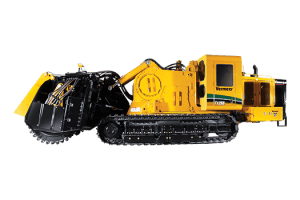
Whether you’re mining limestone, bauxite or one of the many other minerals found around the world, you want the rocks to be broken down to a manageable size. On a mining site, your options are limited by the infrastructure and environment surrounding your work area.
You have two main options: You can drill and blast with explosives and size the rock with a primary crusher, or you can use a continuous surface mining (CSM) method. In most cases, the material being produced by a CSM is a consistent, 5-inch to 10-inch (12.7-cm to 25.4-cm) range with few fines and can be fed directly into a secondary crusher if needed. The Vermeer Terrain Leveler® surface excavation machine (SEM), also known as a surface miner, uses a top-down cutting method that delivers rock-penetrating power through its cutting teeth on a rear-mounted drum.
But there are certain mining sites that require the capabilities of both mining methods. The following are examples of how and when to consider using both continuous surface mining and drill and blast on the same mining site.
Often times, resources aren’t able to be accessed or fully extracted with drill and blast due to close proximity to public roads, urban encroachment, water and gas pipelines, wildlife and environmental challenges, or utilities above- or belowground.
So, what are your options? How do you get those areas you can’t reach with drill and blast? Those areas can often be extracted with continuous surface mining equipment, like the Vermeer T1255III Terrain Leveler SEM.
“Surface mining is a less disruptive mining process, so mine boundaries may be extended to work closer to buildings or power lines,” said John Milligan, a mining manager at Vermeer.
This means ore bodies once rendered not accessible by drill and blast could be incorporated into production. The rear-mounted drum of the Vermeer design allows the operator to cut inside and outside square corners and outer pit boundaries that center-mounted drum machines cannot.
Other times you might run into environmental roadblocks. Dust, noise and seismic vibration issues can prevent you from drilling and blasting. That’s where surface mining can come in and be a neighborhood-friendly option. The Vermeer surface miner equipped with vacuum dust suppression reduces dust while mining. Since there are no high-energy explosives, there are no seismic vibrations or large dust clouds due to the blast, so you can continue to mine in areas even if these environmental issues are a concern.
Another way to use both methods is in seams, the layers in the rock formation that hold different chemistries, rock properties and minerals. After you drill and blast the overburden, you can use a continuous surface miner to accurately and precisely extract narrow seams of ore that would normally be blasted and hauled out with waste, or where waste areas are mixed with quality material. The Vermeer surface miner allows you to precisely mine within a half-inch accuracy, so you can mine the seam completely without leaving massive amounts of waste rock or suffer enormous product dilution from the blast operation.
“The CSM can cut the quality ore with very limited blending of waste material, so you aren’t wasting any opportunity to mine for more material,” said Milligan.
There’s also an opportunity to use both methods when it comes to overburden on a mine site. Overburden is any material above the desired ore product, such as a waste seam above different levels of a pit.
“For mines that have a significant amount of overburden, it might be faster and more cost-effective to blast the overburden and then use continuous surface mining for precision mineral, ore or aggregate extraction,” explained Milligan.
The CSM method can cut the overburden as well as the valuable ore or mineral if you’d rather not drill and blast. However, it may be beneficial to drill and blast off the top of the overburden, haul it out with front-end loaders or excavators, and then use the CSM for precision mining to minimize dilution and not waste good ore.
On large mines, sometimes there’s more work to be done than just mining. There may be other areas around the site that need work or cleanup. A continuous surface miner can be used in these situations, such as road construction and maintenance, as well as other civil engineering projects needed of the mine.
“While drill and blast might be your main method while mining, a continuous surface miner can help with the other areas of your mine site and help you do more than you could before,” said Milligan.
Finally, you can start with a CSM to prepare the top surface to save time on your jobsite. Often, the initial overburden layer can be too irregular in slope or flatness and marked with craters, making it very difficult for a drill rig to traverse. The Vermeer Terrain Leveler SEM can efficiently prepare the surface for the drill rigs to begin work. Then, you can complete the rest of the mining process with drill and blast, or keep using CSM, whichever method you prefer.
While surface mining, and drill and blast are mostly used separately, there are many opportunities when both methods can be beneficial on the same mining sites. Pairing drill and blast and CSM together can enhance your mine site operation and can help make your company more efficient and productive.